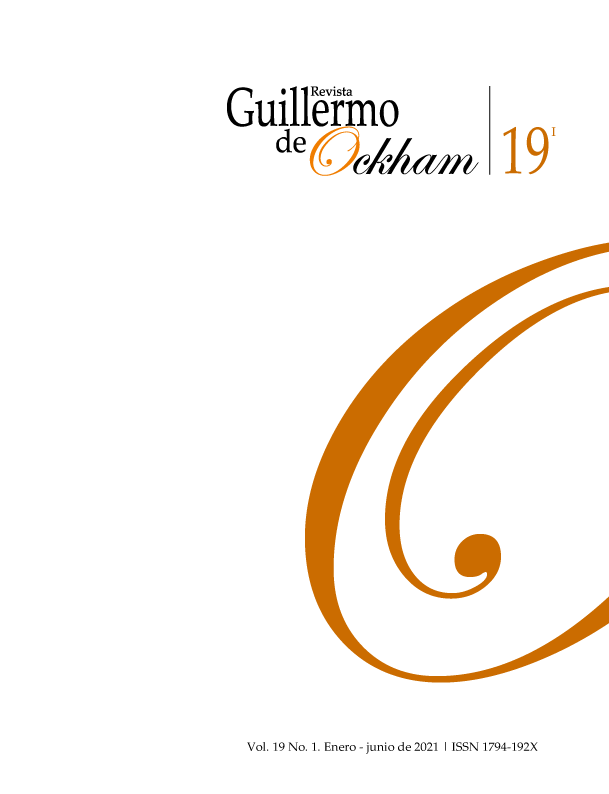The Revista Guillermo de Ockham provides an immediate and open access to its content, based on the principle of offering the public a free access to investigations to provide a global interchange of knowledge.
Unless otherwise established, the contents of this journal has a license with Creative Commons Attribution-NonCommercial-NoDerivatives 4.0 International (CC BY-NC-ND 4.0) http://creativecommons.org/licenses/by-nc-nd/4.0/
- Attribution: You must give appropriate credit, provide a link to the license, and indicate if changes were made. You may do so in any reasonable manner, but not in any way that suggests the licensor endorses you or your use.
- NonCommercial: You may not use the material for commercial purposes.
- NoDerivatives: If you remix, transform, or build upon the material, you may not distribute the modified material.
- No additional restrictions: You may not apply legal terms or technological measures that legally restrict others from doing anything the license permits.
Abstract
The purpose of this article is to explore the idea that, although Zeroness was coined by Deleuze and not by Peirce, there is no problem in considering it as the formal antecedent of Firstness. The argumentation will show that, without Zeroness, God could not have transformed nothingness into the empty set and, therefore, could not have created the elements of Firstness. This can be illustrated by a thought experiment in which it becomes evident that without the empty set, the continua of luminosity and color could not have arisen. In other words, without the Zeroness of the empty set, any attempt to create the colors would have been absorbed in the chaos of nothing.
References
EP2 (1998). The Essential Peirce. Selected Philosophical Writings. Volume 2 (1893-1913). N. Houser et al. (Eds). Indiana University Press.
OFR1 (2012) Obra filosófica reunida. Tomo I (1867 – 1893). (D. McNabb trad.). Fondo de Cultura Económica.
OFR2 (2012). Obra filosófica reunida. Tomo II (1893 – 1913). (D. McNabb trad.). Fondo de Cultura Económica.
PM (2010). Philosophy of Mathematics. Selected Writings. M. E. Moore (Ed.). Indiana University Press.
TCD (2014). The Commens Dictionary: Peirce’s Terms in His Own Words. New. M. Bergman & S. Paavola (Eds.). http://www.commens.org/dictionary
W4 (1989). Writings of Charles S. Peirce. A Chronological Edition. Volume 4 (1879-1884). Christian J. W. Kloesel et al. (Eds.) Indiana University Press.
W6 (2000). Writings of Charles S. Peirce. A Chronological Edition. Volume 6 (1886-1890). N. Houser et al. (eds.) Indiana University Press.
Bowden, S. Bignall, S. y Patton, P. (2014). Deleuzian Encounters with Pragmatism. En Sean Bowden, Simone Bignall y Paul Patton (eds.) Deleuze and Pragmatism. (Primera edición, pp. 1-17). De Gruyter Mouton. Doi: https://doi.org/10.4324/9781315764870
Brier, S. (2014). Pure Zero, en T. Thellefsen and B. Sørensen (Eds.) Charles Sanders Peirce in His Own Words. 100 Years of Semiotics, Communication and Cognition. (Primera edición, pp. 207-212). De Gruyter Mouton. Doi: https://doi.org/10.1515/9781614516415.207
Buczynska-Garewicz, H. (1979). “The degenerate sign”. Semiosis 13. Internationale Zeitschrift für Semiotik und Ästhetik, 4(1), 5-16. URL: https://zkm.de/media/file/de/1979-semiosis-13_05-16_buczynska-garewicz.pdf
Deamer, D. (2014). Deleuze, Japanese Cinema, and the Atom Bomb. The Spectre of Impossibility. Bloomsbury Publishing Inc. Doi: https://doi.org/10.5040/9781501300158
Deamer, D. (2016). Deleuze’s Cinema Books: Three Introductions to the Taxonomy of Images. Edinburgh University Press.
Deledalle, G. (1996). Leer a Peirce hoy. Gedisa.
Deleuze, G. (1983). Cinéma 1. L’image-mouvement. Les Éditions de Minuit.
Deleuze, G. (1985). Cinéma 2. L’image-temps. Les Éditions de Minuit.
Deleuze, G. (1995). Negotiations: 1972-1990. M. Joughin (Trad.). Columbia University Press.
Eco. U. (1976). “Peirce’s Notion of Interpretant”. MLN, 91 (6), 1457-1472. Doi: https://doi.org/10.2307/2907146
Eco, U. (2014). From the Tree to the Labyrinth: Historical Studies on the Sign and Interpretation. Harvard University Press. Doi: https://doi.org/10.4159/9780674728165
Fernandes. D. (2019). Critique of Zeroness: Understanding Deleuze’s (Mis)understanding of Peirce. Cognitio-Estudos: Revista Eletrônica de Filosofia, 16 (1), 55-66. Doi: https://doi.org/10.23925/1809-8428.2019v16i1p55-66
Forster, P. (2011). Peirce and the Threat of Nominalism. Cambridge University Press.
Girel, M. (2014). Peirce’s Reception in France. Just a Beginning. European Journal of Pragmatism and American Philosophy. 4(1), 1-9. Doi: https://doi.org/10.4000/ejpap.485
Gorlée, D.L. (2014). Peirce’s Logotheca. En T. Thellefsen y B. Sørensen (Eds.) Charles Sanders Peirce in His Own Words. 100 Years of Semiotics, Communication and Cognition. (Primera edición, pp. 405-409). De Gruyter Mouton. Doi: https://doi.org/10.1515/9781614516415.405
Ji, S. (2017). Neo-semiotics: Introducing Zeroness into Peircean Semiotics may bridge the Knowable and the Unknowable. Progress in Biophysics and Molecular Biology. 131, 387-401. Doi: https://doi.org/10.1016/j.pbiomolbio.2017.09.012
Ji, S. (2018). The Cell Language Theory: Connecting Mind and Matter. World Scientific Publising Europe Ltd. Doi https://doi.org/10.1142/p758
Liszka, J.J. (1996). A General Introduction to the Semeiotic of Charles Sanders Peirce. Indiana University Press.
Manteghi Fasayi, G. y Akrami, M. (2012). Gilles Deleuze: Beyond Peirce’s Semiotics. The Quarterly Journal of Philosophical Investigations, 6 (11), 15-37. URL: https://journals.tabrizu.ac.ir/article_73.html?lang=en
Merrell, F. (2010). Entangling Forms within Semiosic Processes. De Gruyter Mouton. Doi: https://doi.org/10.1515/9783110245585
Merrell, F. (2014). “Bridging Ancient and Contemporary Knowing”. En T. Thellefsen and B. Sørensen (Eds.) Charles Sanders Peirce in His Own Words. 100 Years of Semiotics, Communication and Cognition. (Primera edición, pp. 235-238). De Gruyter Mouton. Doi: https://doi.org/10.1515/9781614516415.235
Myrvold, W. C. (1995). Peirce on Cantor’s Paradox and the Continuum. Transactions of the Charles S. Peirce Society, 31 (3), 508-541. URL: http://www.jstor.org/stable/40320556
O’Neill, E.R. (1998). Apprehending Deleuze Apprehending Cinema. Film-Philosophy, 2 (1), 1-27. Doi: https://www.euppublishing.com/doi/pdfplus/10.3366/film.1998.0002
Potter, V. G. y Shields, P.B. (1977). Peirce’s Definitions of Continuity. Transactions of the Charles S. Peirce Society, 13 (1), 20-34. URL: http://www.jstor.org/stable/40319797
Quilter, J.G. (2010). Ontology and Providence in Creation: Taking Ex Nihilo Seriously (review). Ars Disputandi. 10 (1) 52-58. Doi: https://doi.org/10.1080/15665399.2010.10820015
Rodowick, D.N. (1997). Gilles Deleuze’s Time Machine. Duke University Press. Doi: https://doi.org/10.1215/9780822396871
Rossi, M. (2019). The Republic of Color. Science, Perception, and the Making of Modern America. The University of Chicago Press. Doi: https://doi.org/10.7208/chicago/9780226651866.001.0001
Saunders, B. (2009). Peirce on Colour (with Reference to Wittgenstein). En J. Wang, K. Puhl, and V. A. Munz (Eds.) A Selection of Papers from the International Wittgenstein Symposia in Kirchberg am Wechse. URL: http://wittgensteinrepository.org/agora-alws/article/view/2814/3352
Sonesson, G. (2013). The Natural History of Branching: Approaches to the Phenomenology of Firstness, Secondness, and Thirdness. Signs and Society, 1 (2), 297-325. Doi: https://doi.org/10.1086/673251
Spinks, C.W. (1991). Peirce and Triadomania. A Walk in the Semiotic Wilderness. Mouton de Gruyter. Doi: https://doi.org/10.1515/9783110854114
Stivale, C.J. (2003). Deleuze on Cinema (review). Criticism, 45(4), 529-532. Doi: https://doi.org/10.1353/crt.2004.0027
Vericat, J.F. (1994). Color as Abstraction. En G. Debrock y M. Hulswit (Eds.) Living Doubt: Essays concerning the Epistemology of Charles Sanders Peirce. (1994, pp. 289-302). Kluwer Academic. Doi: https://doi.org/10.1007/978-94-015-8252-0_26

 Perfil Google Scholar
Perfil Google Scholar































